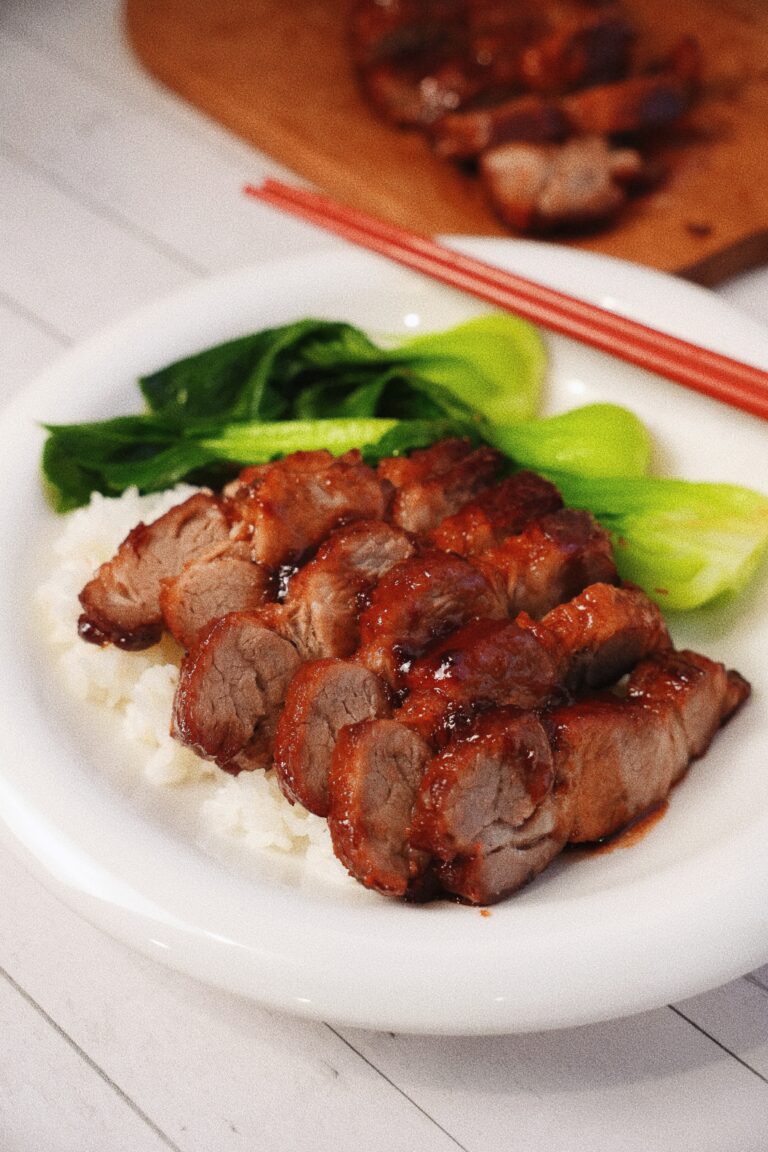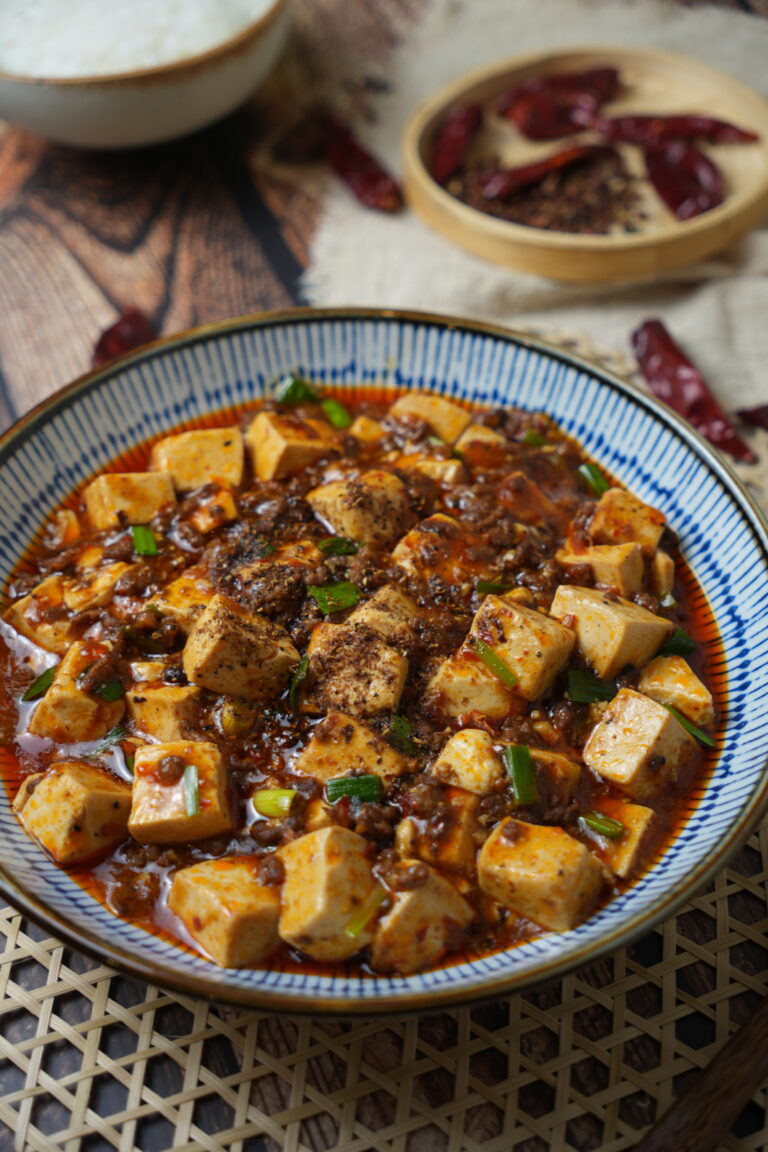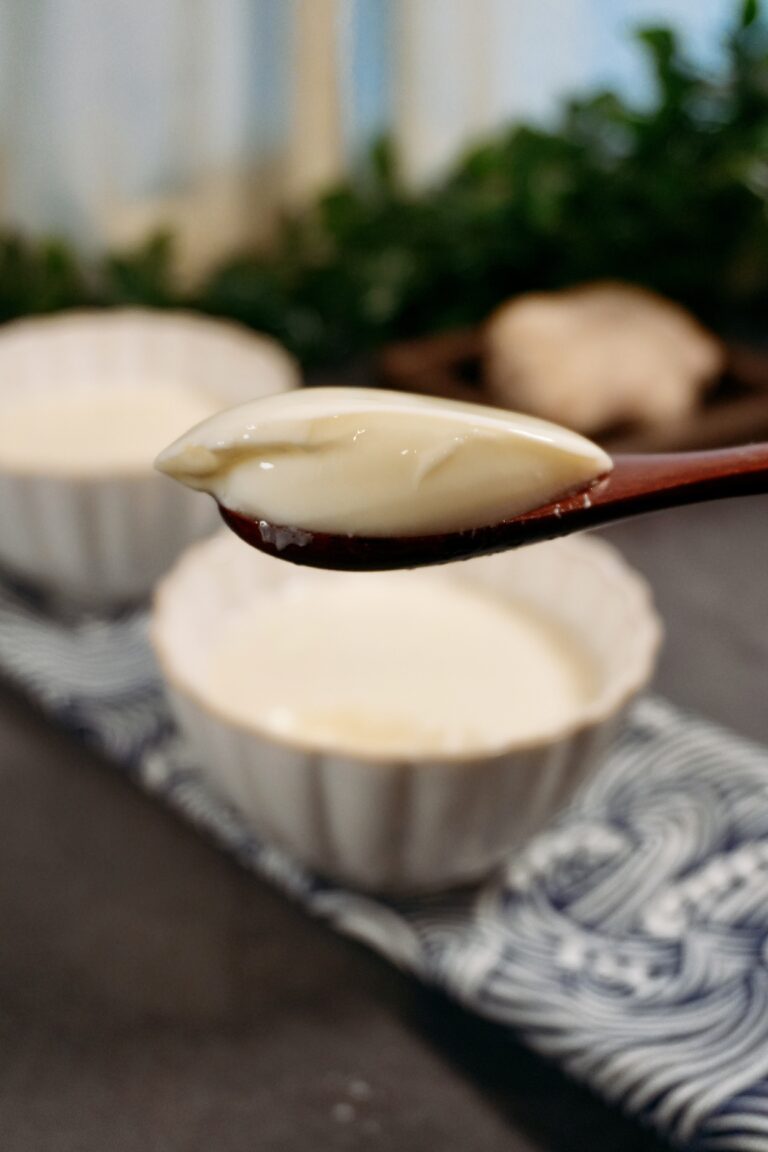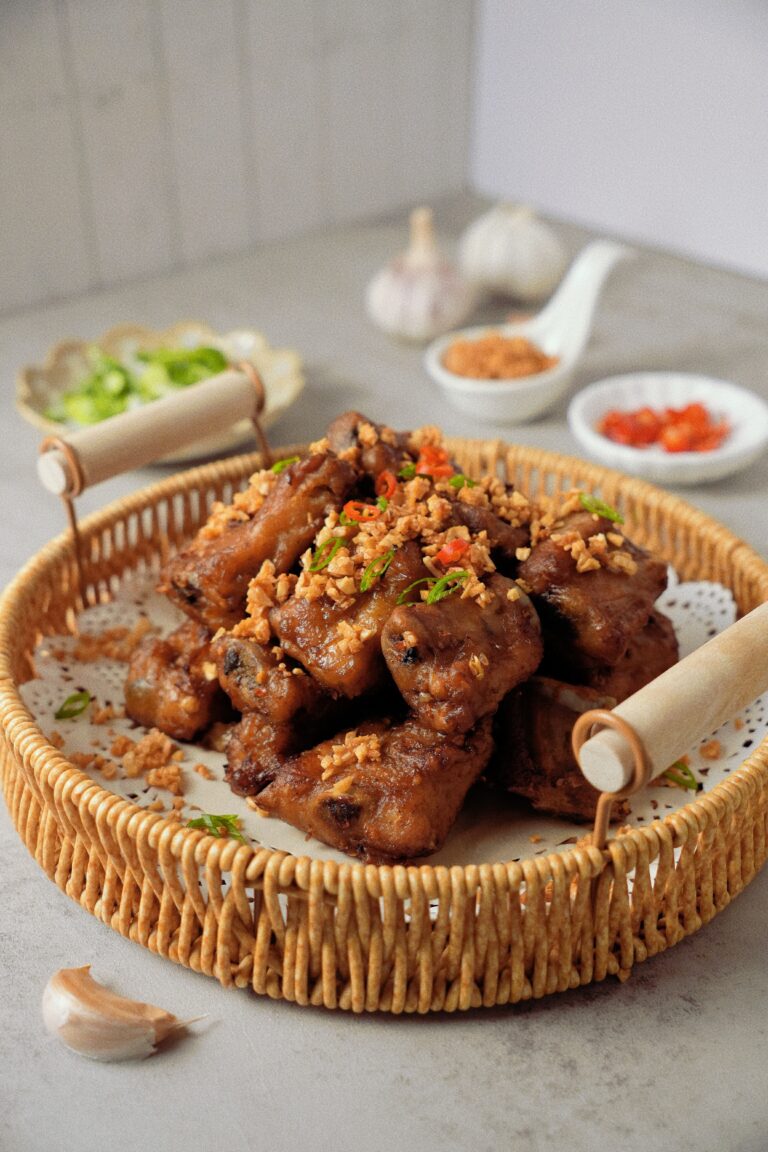Chinese-Style Braised Beef Back Ribs: The Hidden Gem of Beef Cuts
Chinese-Style Braised Beef Back Ribs — I think they’re the secret too good to keep but too delicious not to share. The meat becomes impossibly tender, pulling away from the bone with the gentlest tug. The sauce, infused with the gelatin from the long-cooked collagen, clings to each morsel with a silky richness. Each bite offers a perfect balance of savory depth, subtle sweetness, and aromatic complexity.
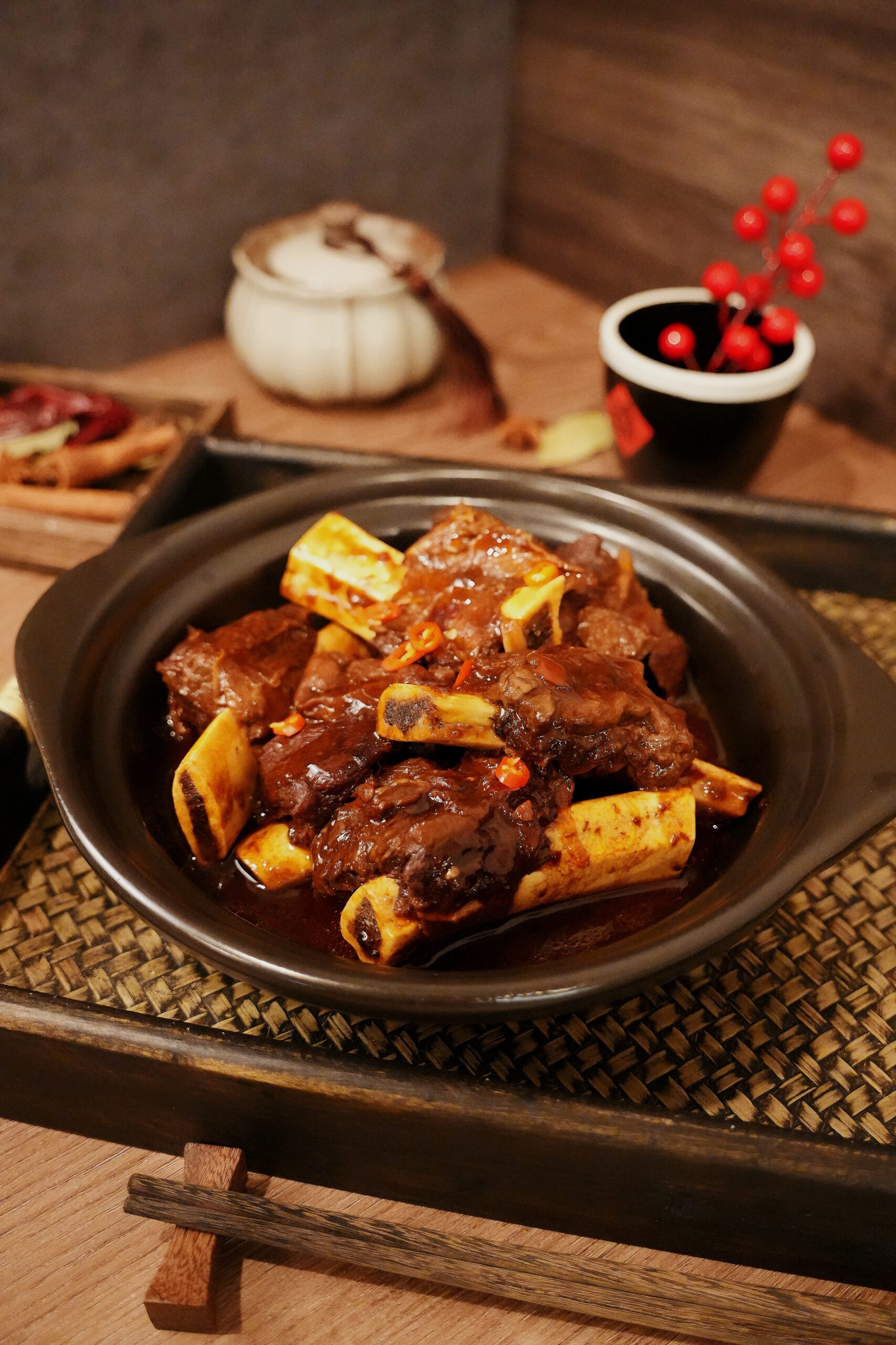
Finding Culinary Treasures
I still remember the first time I discovered beef back ribs. I was at my local butcher, wincing at the prices of premium cuts and stewing beef, when I noticed these substantial, meaty bones tucked away in the corner of the display case. They were $4.99/lb, vs. $10.99/lb for stewing beef. The price was so reasonable that I was immediately suspicious—what was wrong with them? Was there some fatal flaw I wasn’t seeing?
Oh beef back ribs! I recall having them at a Chinese restaurant where the meat was incredibly tender and juicy, with a silky and slightly bouncy texture. I know you’re paying for bone as well, but you still get a good piece of meat and it has perfect marbling to it, so I decided to give it a try. You probably can already guess. The result was incredible. The flavor was so rich that it almost had a butter-like taste. I’m sharing this recipe which has become one of my favorite dishes.
If you like beef stews, try this Instant Pot Chinese style beef stew or my favorite beef noodle soup.

Why Beef Back Ribs Deserve Your Attention
The meat nestled between and around those bones is rich with connective tissue and marbling that, when cooked slowly, transforms into something extraordinary. The collagen breaks down into gelatin, creating a silky mouthfeel that simply cannot be replicated with leaner cuts. There’s a richness and depth of flavor that emerges during the long, slow cooking process that makes every bite a revelation. This part comes from an area of the cow that doesn’t get much exercise, which helps keep the meat naturally tender and flavorful.
They cost a fraction of what you’d pay for other premium cuts. In a world of ever-increasing food prices, beef back ribs remain one of the last great bargains in the meat case.
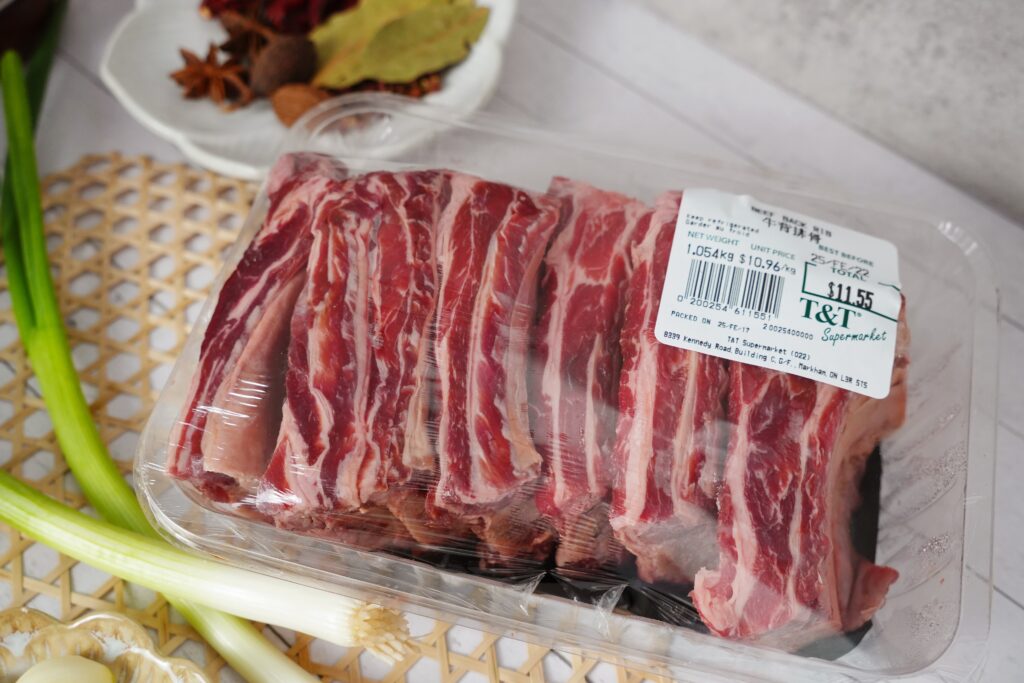
Chinese-Style Braised Beef Back Ribs
After experimenting with different combinations of condiments, Chinese-style braising brings out the absolute best in beef back ribs. The combination of aromatic spices, umami-rich bean pastes, and the sweet-salty balance of traditional Chinese sauces perfectly complements the robust beef flavor.

Ingredients:
- 2-2.5 pounds beef back ribs, cut into 1 rib sections
- 2 tbsp neutral oil (like canola or peanut)
Aromatics:
- 8 cloves garlic, smashed
- 2 green onions, cut in half
- 1 tbsp ginger slices
- 4 dried bird eye chilis
- 1 tsp Sichuan peppercorn
- 3-4 bay leaves
- 2 star anise
- 2 black cardamom (optional)
Seasonings:
- 2 tbsp Shaoxing wine
- 1 tbsp soybean paste
- 1 tbsp spicy soybean paste (Doubanjiang)
- 2 tbsp light soy sauce
- 2 tsp dark soy sauce
- 1 tbsp brown sugar
- 1/2 tsp white pepper
- Salt to taste
- 1 tbsp cornstarch mixed with 2 tbsp cold water (optional, for thickening)
Instructions:
1. Soak the Meat
Soak the ribs in cold water for at least two hours, changing the water once halfway through. This crucial step removes excess blood and impurities that can cloud the flavor of the final dish. Alternatively, blanch the meat briefly, though this may remove more flavor.
After soaking, rinse the ribs thoroughly under cold running water and pat them dry with paper towels to limit oil splatter during cooking.
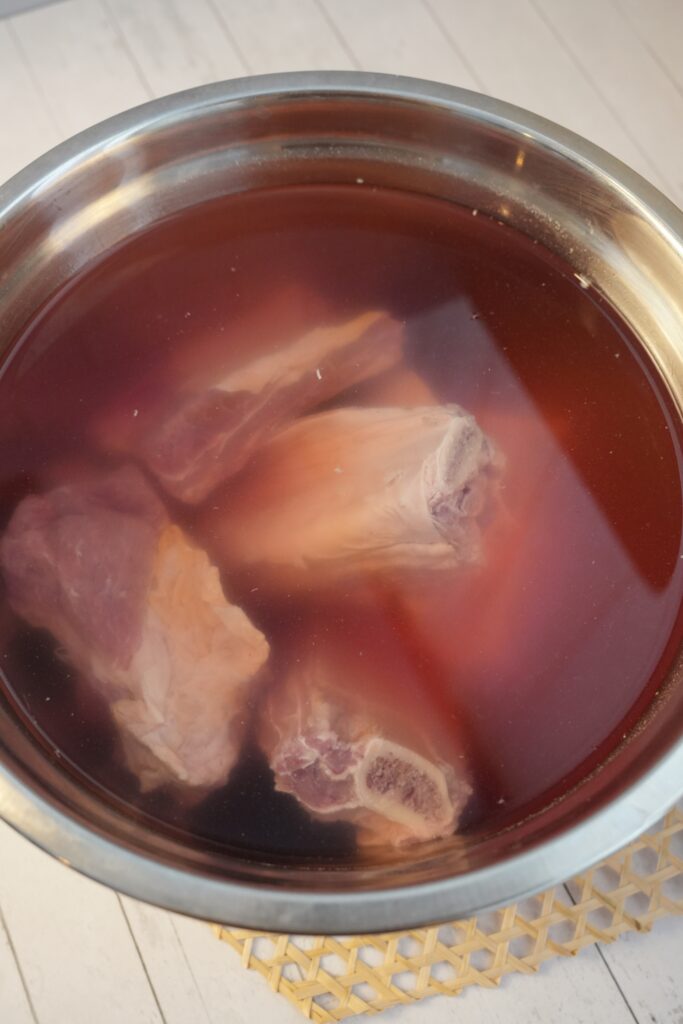
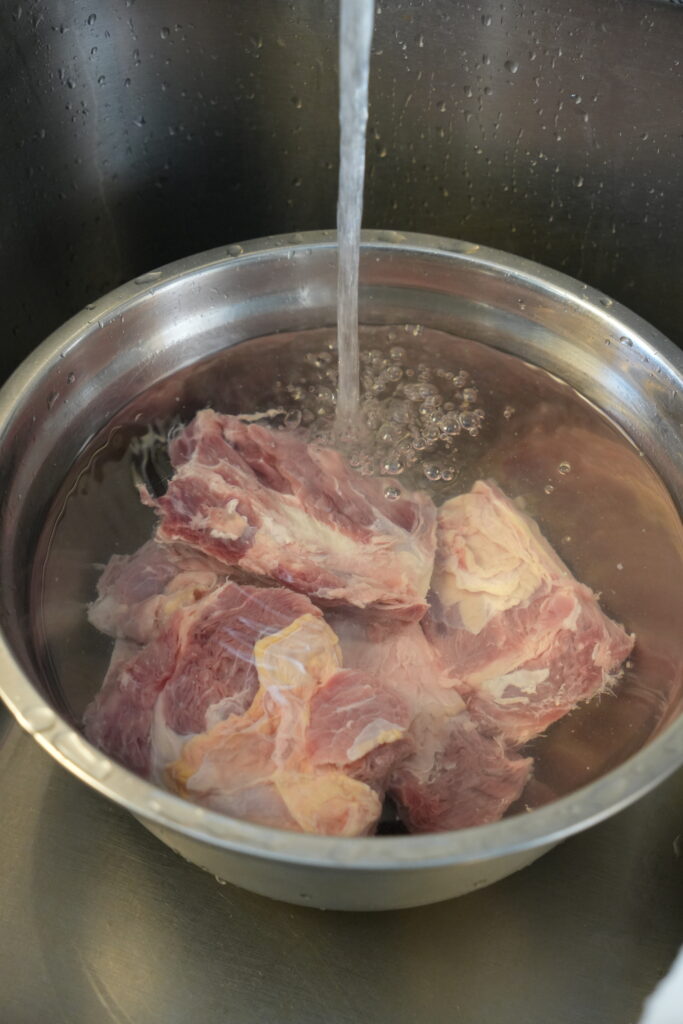
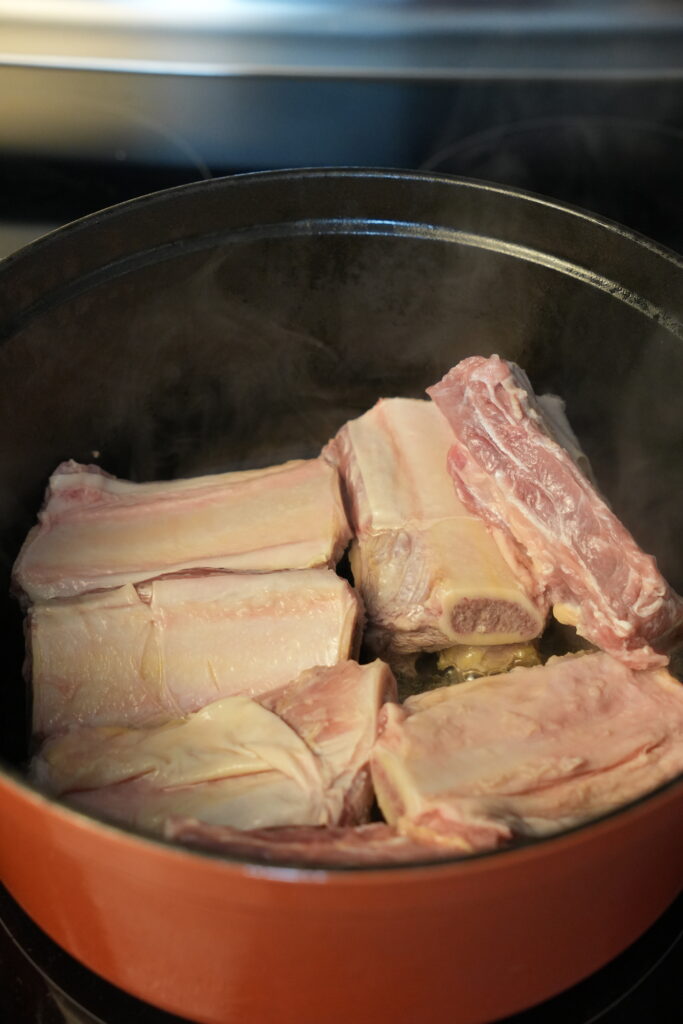
2. Sear the Ribs
Heat a heavy cast iron pot with 2 tbsp of oil. Lay the meat in an even layer and sear each side until it develops a deep golden crust. This caramelization creates new flavor compounds that will infuse the entire dish.
3. Add Aromatics
Once the ribs are beautifully seared, push them to one side of the pot and add the soybean paste and spicy doubanjiang to the cleared space. Sauté briefly, just until their oils are released and their color deepens slightly—about 30 seconds—then stir to coat the ribs in this aromatic mixture.
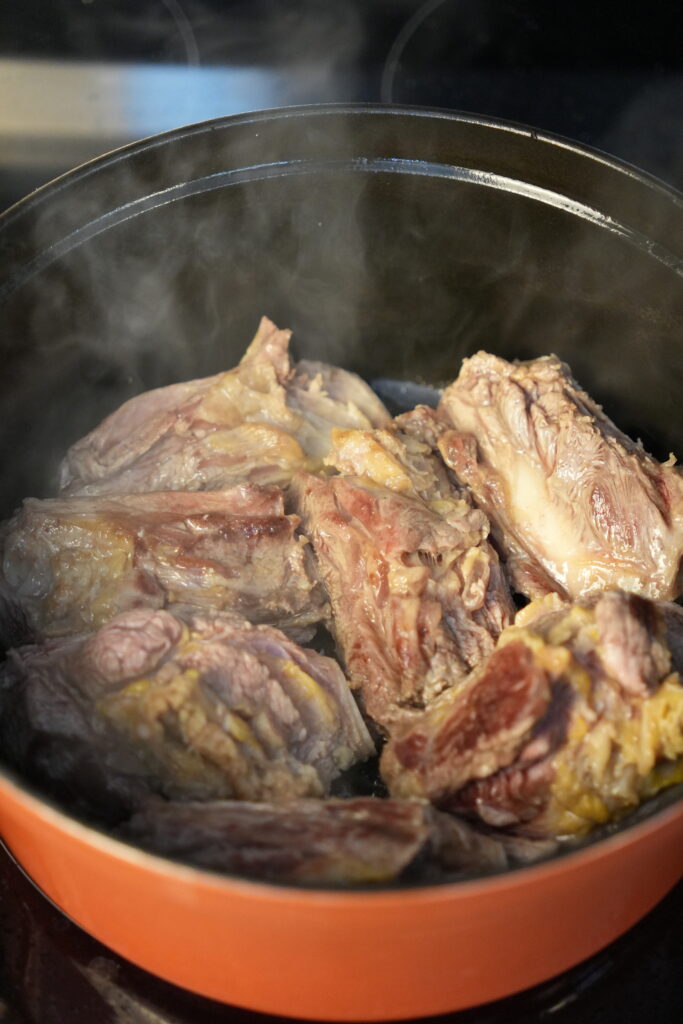
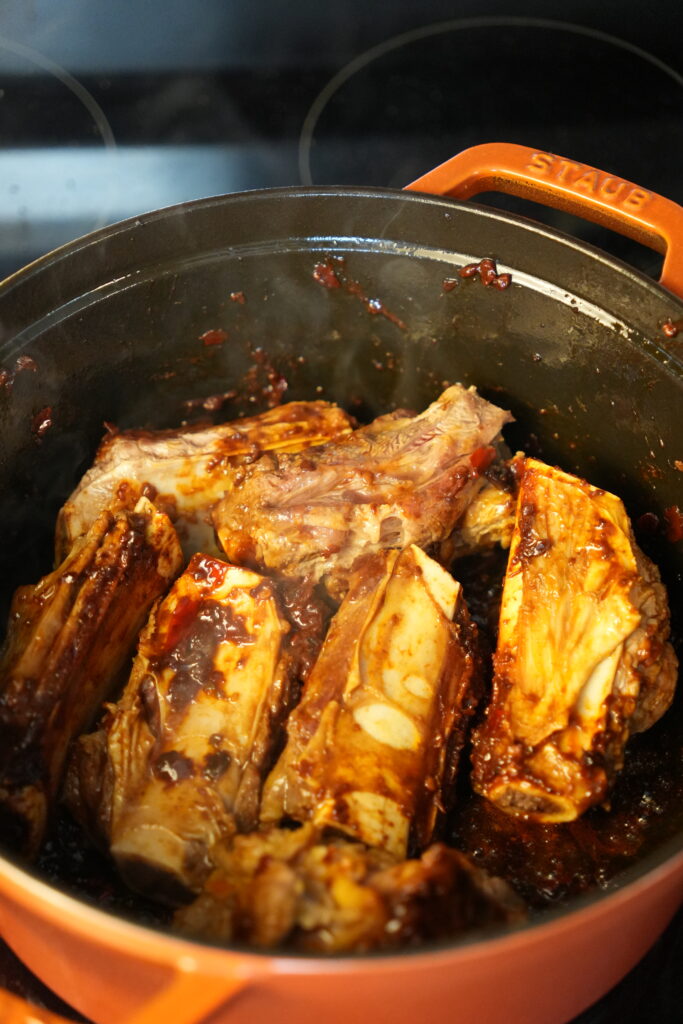
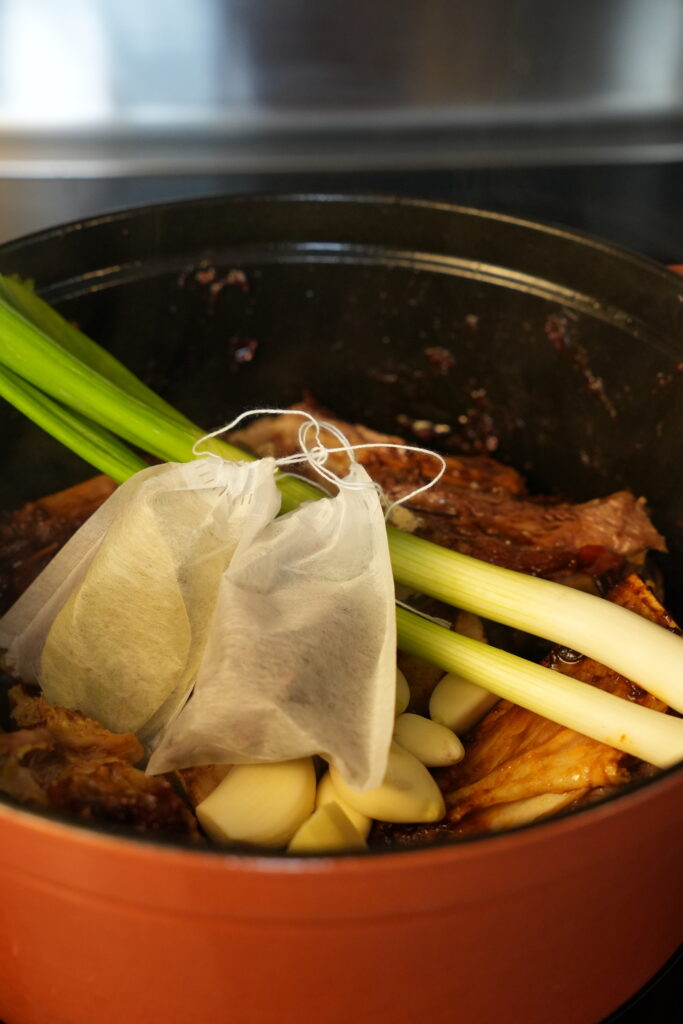
4. Build Flavor Layers
Add Shaoxing wine first, allowing the alcohol to cook off for a minute while deglazing the pot to capture all the browned bits from searing. Then add the soy sauces, white pepper, brown sugar, and all the aromatics—garlic, ginger, green onions, dried chilis, Sichuan peppercorn, bay leaves, star anise, and cardamom if using.
5. Slow Cook
Add just enough water to cover the ribs. Reduce the heat to maintain a gentle simmer, cover the pot, and cook for about two hours, checking occasionally to prevent burning. If the liquid evaporates too quickly, add hot water as needed. Never use cold water as it will shock the beef and make it tough.
For a quicker alternative, a pressure cooker reduces cooking time to about 45 minutes, though the flavor may not be quite as developed as with the slow-simmer method.
6. Finish the Sauce
When the meat is tender enough to pull away from the bone with minimal resistance, remove the lid, pick out the aromatics for a cleaner presentation, and turn up the heat to reduce the sauce as desired. This is the time to taste and adjust seasonings.
For a thicker sauce, add cornstarch slurry gradually while stirring to avoid lumps, until reaching the desired consistency. This step is optional but creates a sauce that clings beautifully to both meat and rice.

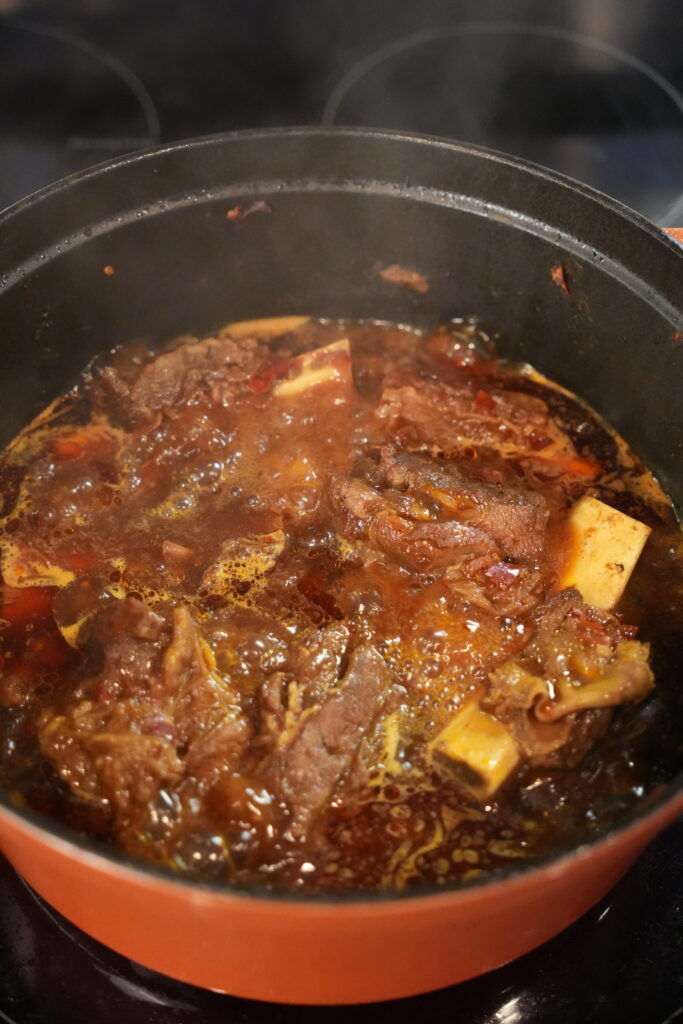
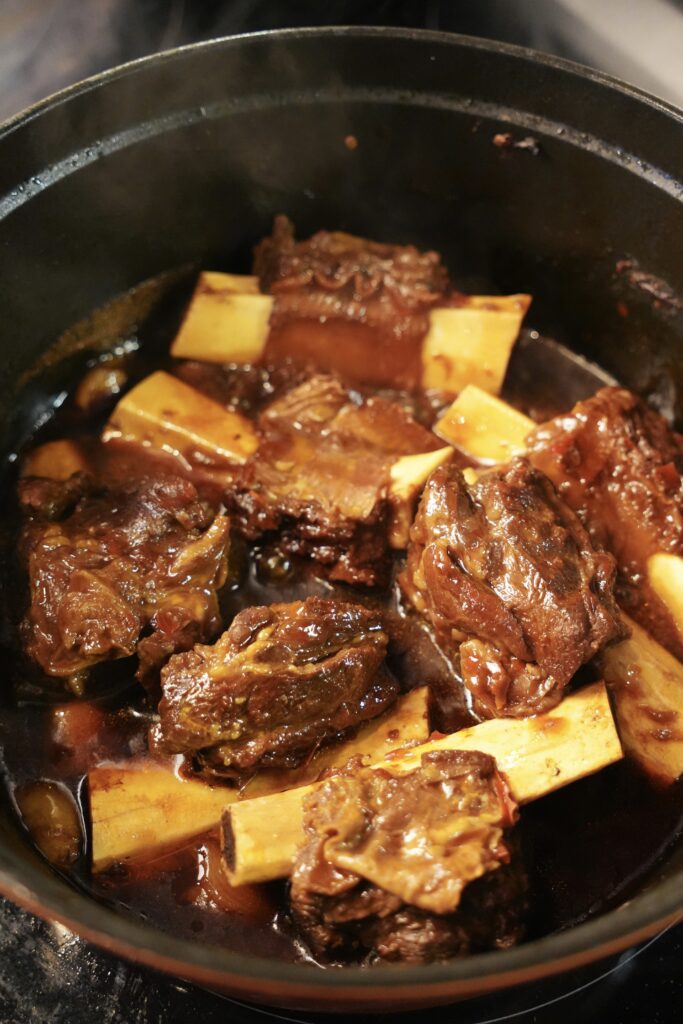
The Moment of Truth
The first time I served these Chinese-Style Braised Beef Back Ribs to my family, they finished the whole pot! (it was a big batch). Even my five-year-old daughter had two pieces (it is a bit spicy and she doesn’t like spicy! but the meat was too good that she couldn’t hold herself!). Give it a try and hope you will enjoy it as much as we do. Love!
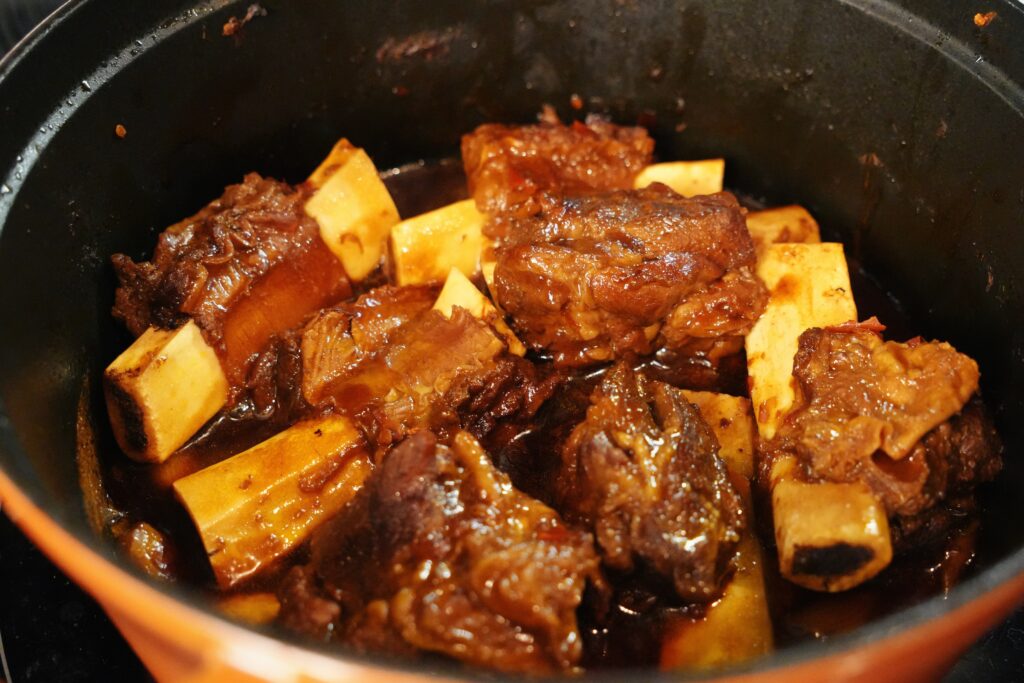
Storage and Reheating
To store: Once the ribs have cooled completely, transfer them to an airtight container with the sauce and refrigerate for up to 3-4 days. The fat will solidify on top—this is normal and actually helps preserve the dish. You can either remove this fat layer before reheating or stir it back in for extra richness.
For longer storage, these ribs freeze beautifully for up to 3 months. They’re best frozen with plenty of sauce in freezer-safe containers, leaving some room at the top for expansion.
To reheat: For refrigerated ribs, place them with the sauce in a pot over low heat, adding a splash of water if the sauce seems too thick. Cover and warm slowly until heated through, about 10-15 minutes. Or microwave with some water in 1-2 minute intervals for 4-5 minutes until heated through.
For frozen ribs, thaw overnight in the refrigerator before reheating using the same method. In a pinch, you can reheat from frozen in a covered pot with a little added water, but do it over very low heat to maintain the tender texture.
These ribs are perfect for meal prep. Consider making a double batch on Sunday to enjoy throughout the week. The flavor just keeps getting better!

Chinese-Style Braised Beef Back Ribs
Ingredients
- 2-2.5 pounds beef back ribs cut into 1 rib sections
- 2 tbsp neutral oil like canola or peanut
Aromatics:
- 8 cloves garlic smashed
- 2 green onions cut in half
- 1 tbsp ginger slices
- 4 dried bird eye chilis
- 1 tsp Sichuan peppercorn
- 3-4 bay leaves
- 2 star anise
- 2 black cardamom optional if you have it
Seasonings:
- 2 tbsp Shaoxing wine
- 1 tbsp soybean paste
- 1 tbsp spicy soybean paste Doubanjiang
- 2 tbsp light soy sauce
- 2 tsp dark soy sauce
- 1 tbsp brown sugar
- 1/2 tsp white pepper
- salt to taste
- 1 tbsp cornstarch mixed with 2 tbsp cold water optional, for thickening
Instructions
Soak the Meat
- Soak the ribs in cold water for at least two hours, changing the water once halfway through. Alternatively, blanch the meat briefly, though this may remove more flavor.
- After soaking, rinse the ribs thoroughly under cold running water and pat them dry with paper towels to limit oil splatter during cooking.
Sear the Ribs
- Heat a heavy cast iron pot with 2 tbsp of oil. Lay the meat in an even layer and sear each side until it develops a deep golden crust.
Add Aromatics and Seasoning
- Once the ribs are beautifully seared, push them to one side of the pot and add the soybean paste and spicy doubanjiang to the cleared space. Sauté briefly, just until their oils are released and their color deepens slightly — about 30 seconds. Then stir to coat the ribs in this aromatic mixture.
- Add Shaoxing wine first, allowing the alcohol to cook off for a minute while deglazing the pot to capture all the browned bits from searing.
- Then add the soy sauces, white pepper, brown sugar, and all the aromatics—garlic, ginger, green onions, dried chilis, Sichuan peppercorn, bay leaves, star anise, and cardamom if using.
Slow Cook
- Add just enough water to cover the ribs. Reduce the heat to maintain a gentle simmer, cover the pot, and cook for about two hours, checking occasionally to prevent burning. If the liquid evaporates too quickly, add hot water as needed. Never use cold water as it will shock the beef and make it tough.
- For a quicker alternative, a pressure cooker reduces cooking time to about 45 minutes, though the flavor may not be quite as developed as with the slow-simmer method.
Finish the Sauce
- When the meat is tender enough to pull away from the bone with minimal resistance, remove the lid, pick out the aromatics for a cleaner presentation, and turn up the heat to reduce the sauce as desired. Taste and adjust seasonings.
- For a thicker sauce, add cornstarch slurry gradually while stirring to avoid lumps, until reaching the desired consistency. Serve hot with rice or noodles.


